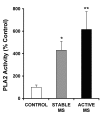Secreted phospholipase A2 activity in experimental autoimmune encephalomyelitis and multiple sclerosis
- PMID: 16965627
- PMCID: PMC1592473
- DOI: 10.1186/1742-2094-3-26
Secreted phospholipase A2 activity in experimental autoimmune encephalomyelitis and multiple sclerosis
Abstract
Background: There is increased interest in the contribution of the innate immune system to multiple sclerosis (MS), including the activity of acute inflammatory mediators. The purpose of this study was to test the involvement of systemic secreted phospholipase A2 (sPLA2) enzymes in experimental autoimmune encephalomyelitis (EAE), an MS model, and to determine if enzyme activity is elevated in MS patients.
Methods: A non-invasive urinary assay was developed in order to monitor enzymatically active sPLA2 levels in Dark Agouti rats after induction of EAE. Some Rats were treated with nonapeptide CHEC-9, an uncompetitive sPLA2 enzyme inhibitor, during the initial rise in urinary enzyme levels. Body weight and clinical EAE score were measured for 18 days post immunization (PI), after which the rats were sacrificed for H&E and myelin staining, and for ED-1 immunocytochemistry, the latter to quantify macrophages and activated microglia. The urinary sPLA2 assay was also applied to un-timed samples collected from a cross section of 44 MS patients and 14 healthy controls.
Results: Mean levels of enzymatically active sPLA2 in the urine increased following immunization and peaked between days 8-10 PI which was just prior to the onset of EAE symptoms. At this time, a transient attenuation of activity was detected in the urine of CHEC-9 treated rats consistent with the activity-dependent properties of the inhibitor. The peptide also reduced or abolished EAE symptoms compared to vehicle-injected controls. Histopathological changes in the spinal cords of the EAE rats correlated generally with clinical score including a significant reduction in ED-1+ cells after peptide treatment. Multiple Sclerosis patients also showed elevations in sPLA2 enzyme activity. Mean levels of sPLA2 were increased 6-fold in the urine of patients with active disease and 4-fold for patients in remission, regardless of immunomodulating therapy.
Conclusion: The results suggest that sPLA2 enzymes, traditionally thought to be part the acute phase inflammatory response, are therapeutic targets for MS.
Figures




Similar articles
-
Ribavirin reduces clinical signs and pathological changes of experimental autoimmune encephalomyelitis in Dark Agouti rats.J Neurosci Res. 2003 Apr 15;72(2):268-78. doi: 10.1002/jnr.10552. J Neurosci Res. 2003. PMID: 12672002
-
VEGF and angiogenesis in acute and chronic MOG((35-55)) peptide induced EAE.J Neuroimmunol. 2009 Apr 30;209(1-2):6-15. doi: 10.1016/j.jneuroim.2009.01.009. Epub 2009 Feb 23. J Neuroimmunol. 2009. PMID: 19233483
-
Dry olive leaf extract ameliorates experimental autoimmune encephalomyelitis.Clin Nutr. 2009 Jun;28(3):346-50. doi: 10.1016/j.clnu.2009.03.014. Epub 2009 Apr 21. Clin Nutr. 2009. PMID: 19386399
-
Steroid protection in the experimental autoimmune encephalomyelitis model of multiple sclerosis.Neuroimmunomodulation. 2008;15(1):76-83. doi: 10.1159/000135627. Epub 2008 Jul 29. Neuroimmunomodulation. 2008. PMID: 18667803
-
The role of phospholipase A2 in multiple Sclerosis: A systematic review and meta-analysis.Mult Scler Relat Disord. 2019 Jan;27:206-213. doi: 10.1016/j.msard.2018.10.115. Epub 2018 Oct 30. Mult Scler Relat Disord. 2019. PMID: 30412818
Cited by
-
Differing roles for members of the phospholipase A2 superfamily in experimental autoimmune encephalomyelitis.Brain. 2009 May;132(Pt 5):1221-35. doi: 10.1093/brain/awp002. Epub 2009 Feb 13. Brain. 2009. PMID: 19218359 Free PMC article.
-
The role of secretory phospholipase A₂ in the central nervous system and neurological diseases.Mol Neurobiol. 2014 Apr;49(2):863-76. doi: 10.1007/s12035-013-8565-9. Epub 2013 Oct 10. Mol Neurobiol. 2014. PMID: 24113843 Review.
-
Cerebrospinal fluid secretory Ca2+-dependent phospholipase A2 activity: a biomarker of blood-cerebrospinal fluid barrier permeability.Neurosci Lett. 2010 Jul 12;478(3):179-83. doi: 10.1016/j.neulet.2010.05.012. Epub 2010 May 12. Neurosci Lett. 2010. PMID: 20470866 Free PMC article.
-
Distribution of secretory phospholipase A2 XIIA in the brain and its role in lipid metabolism and cognition.Mol Neurobiol. 2014 Aug;50(1):60-75. doi: 10.1007/s12035-014-8635-7. Epub 2014 Jan 25. Mol Neurobiol. 2014. PMID: 24464264
-
Product inhibition of secreted phospholipase A2 may explain lysophosphatidylcholines' unexpected therapeutic properties.J Inflamm (Lond). 2008 Oct 22;5:17. doi: 10.1186/1476-9255-5-17. J Inflamm (Lond). 2008. PMID: 18945345 Free PMC article.
References
-
- Cummings BS, McHowat J, Schnellmann RG. Phospholipase A(2)s in cell injury and death. J Pharmacol Exp Ther. 2000;294:793–799. - PubMed
LinkOut - more resources
Full Text Sources
Other Literature Sources
Research Materials
Miscellaneous

